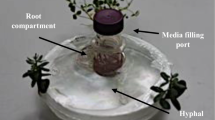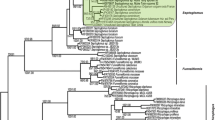Abstract
The cultivation of the ectomycorrhizal fungus Tuber melanosporum has considerably spread in recent years throughout the world. During the first years of truffle cultivation, weed control is a key practice to improve the establishment of host trees and the proliferation of the fungus in the soil. Glyphosate is nowadays the most commonly used herbicide in Spanish truffle orchards. We explored the effect of glyphosate on the proliferation of T. melanosporum mycorrhizae, on extraradical mycelium and on the inoculum potential of T. melanosporum spores in greenhouse experiments using Quercus ilex seedlings as host plants. No detrimental effect on the secondary infection of T. melanosporum was found after three sequential glyphosate applications in young seedlings during one vegetative period. Instead, a change in the distribution of fine roots and T. melanosporum mycorrhizae along soil depth was observed. On the other hand, results indicate that high application rates of glyphosate hinder the infectivity of T. melanosporum spore inoculum, without apparent impact on the host performance. Our results suggest that glyphosate has the potential to jeopardise the role of the soil spore bank as inoculum source for the colonisation of new roots, also raising the question of whether glyphosate could hinder the presumed role of spores in sexual mating.
Similar content being viewed by others
Data availability
The datasets used and/or analysed during the current study are available from the corresponding author on reasonable request.
Code availability
Not applicable.
References
Agerer R (2002) Colour atlas of Ectomycorrhizae 1st-12th del. Eihorn-Verlag, Berlin
Andres-Alpuente A, Sanchez S, Martin M et al (2014) Comparative analysis of different methods for evaluating quality of Quercus ilex seedlings inoculated with Tuber melanosporum. Mycorrhiza 24:S29–S37. https://doi.org/10.1007/s00572-014-0563-x
Bai SH, Ogbourne SM (2016) Glyphosate: environmental contamination, toxicity and potential risks to human health via food contamination. Environ Sci Pollut Res 23:18988–19001. https://doi.org/10.1007/s11356-016-7425-3
Bates D, Maechler M, Bolker B, Walker S (2015) Fitting linear mixedeffects models using lme4. J Stat Softw 67:1–48. https://doi.org/10.18637/jss.v067.i01
Benson DA, Karsch-Mizrachi I, Lipman DJ et al (2005) GenBank. Nucleic Acids Res 33:D34–D38. https://doi.org/10.1093/nar/gki063
Bento CPM, Yang X, Gort G et al (2016) Persistence of glyphosate and aminomethylphosphonic acid in loess soil under different combinations of temperature, soil moisture and light/darkness. Sci Total Environ 572:301–311. https://doi.org/10.1016/j.scitotenv.2016.07.215
Benucci GMN, Bonito GM (2016) The truffle microbiome: species and geography effects on bacteria associated with fruiting bodies of hypogeous Pezizales. Microb Ecol 72:4–8. https://doi.org/10.1007/s00248-016-0755-3
Bonet JA, Fischer CR, Colinas C (2006) Cultivation of black truffle to promote reforestation and land-use stability. Agron Sustain Dev 26:69–76. https://doi.org/10.1051/agro:2005059
Cubera E, Moreno G, Solla A, Madeira M (2012) Root system of Quercus suber L. seedlings in response to herbaceous competition and different watering and fertilisation regimes. Agrofor Syst 85:205–214. https://doi.org/10.1007/s10457-012-9492-x
Druille M, Cabello MN, García Parisi PA et al (2015) Glyphosate vulnerability explains changes in root-symbionts propagules viability in pampean grasslands. Agric Ecosyst Environ 202:48–55. https://doi.org/10.1016/j.agee.2014.12.017
Garcia-Barreda S, Molina-Grau S, Reyna S (2017) Fertilisation of Quercus seedlings inoculated with tuber melanosporum: effects on growth and mycorrhization of two host species and two inoculation methods. IForest 10. https://doi.org/10.3832/ifor2096-009
Gardes M, Bruns TD (1993) ITS primers with enhanced specificity for basidiomycetes - application to the identification of mycorrhizae and rusts. Mol Ecol 2:113–118. https://doi.org/10.1111/j.1365-294X.1993.tb00005.x
Gomes Le Manac’h SG MP, Hénault-Ethier L et al (2017) Glyphosate-dependent inhibition of photosynthesis in willow. Front Plant Sci 8:207. https://doi.org/10.3389/fpls.2017.00207
Iotti M, Zambonelli A (2006) A quick and precise technique for identifying ectomycorrhizas by PCR. Mycol Res 110:60–65. https://doi.org/10.1016/j.mycres.2005.09.010
Jones MD, Durall DM, Cairney JWG (2003) Ectomycorrhizal fungal communities in young forest stands regenerating after clearcut logging. New Phytol 157:399–422. https://doi.org/10.1046/j.1469-8137.2003.00698.x
Kõljalg U, Nilsson RH, Abarenkov K et al (2013) Towards a unified paradigm for sequence-based identification of fungi. Mol Ecol 22:5271–5277. https://doi.org/10.1111/mec.12481
Kwiatkowska M, Michałowicz J, Jarosiewicz P et al (2020) Evaluation of apoptotic potential of glyphosate metabolites and impurities in human peripheral blood mononuclear cells (in vitro study). Food Chem Toxicol 135:110888. https://doi.org/10.1016/j.fct.2019.110888
Le Tacon F (2017) Les truffes Biologie, écologie et domestication. AgroParisTech, Nancy
Mamoun M, Olivier JM (1997) Mycorrhizal inoculation of cloned hazels by Tuber melanosporum: effect of soil disinfestation and co-culture with Festuca ovina. Plant Soil 188:221–226. https://doi.org/10.1023/A:1004267405566
Olivera A, Fischer CR, Bonet JA et al (2011) Weed management and irrigation are key treatments in emerging black truffle (Tuber melanosporum) cultivation. New For 42:227–239. https://doi.org/10.1007/s11056-011-9249-9
Olivier J-M, Savignac J-C, Sourzat P (1996) Truffe et, trufficulture edn. Fanlac, Périgueux, France
Parladé J, Hortal S, Pera J, Galipienso L (2007) Quantitative detection of Lactarius deliciosus extraradical soil mycelium by real-time PCR and its application in the study of fungal persistence and interspecific competition. J Biotechnol 128:14–23. https://doi.org/10.1016/j.jbiotec.2006.09.010
Pereira G, Palfner G, Chávez D et al (2013) Using common mycorrhizal networks for controlled inoculation of Quercus spp. with Tuber melanosporum: the nurse plant method. Mycorrhiza 23:373–380. https://doi.org/10.1007/s00572-013-0480-4
Pinheiro J, Bates D, DebRoy S, R Core Team (2019) _nlme: linear and nonlinear mixed effects models_
R Core Team (2019) R: a language and environment for statistical computing
Reyna S, Colinas C (2012) Truficultura. In: Reyna S (ed) Truficultura: Fundamentos y técnicas, 2nd, editio edn. Mundi-Prensa, Madrid, pp 235–274
Reyna S, Garcia-Barreda S (2014) Black truffle cultivation: a global reality. For Syst 23:317–328. https://doi.org/10.5424/fs/2014232-04771
Rose MT, Cavagnaro TR, Scanlan CA, et al (2016) Impact of herbicides on soil biology and function. In: Advances in agronomy. Academic Press Inc., pp 133–220
Silva V, Montanarella L, Jones A et al (2018) Distribution of glyphosate and aminomethylphosphonic acid (AMPA) in agricultural topsoils of the European Union. Sci Total Environ 621:1352–1359. https://doi.org/10.1016/j.scitotenv.2017.10.093
Splivallo R, Ottonello S, Mello A, Karlovsky P (2011) Truffle volatiles: from chemical ecology to aroma biosynthesis. New Phytol 189:688–699. https://doi.org/10.1111/j.1469-8137.2010.03523.x
Taschen E, Rousset F, Sauve M et al (2016) How the truffle got its mate: insights from genetic structure in spontaneous and planted Mediterranean populations of Tuber melanosporum. Mol Ecol 25:5611–5627. https://doi.org/10.1111/mec.13864
Trappe JM, Molina R, Castellano M (1984) Reactions of mycorrhizal fungi and mycorrhiza formation to pesticides. Annu Rev Phytopathol 22:331–359. https://doi.org/10.1146/annurev.py.22.090184.001555
Verlhac A, Giraud M, Leteinturier J (1990) La truffe, guide pratique. Ctifl, Paris
White T, Bruns TD, Lee S, Taylor J (1990) Amplification and direct sequencing of fungal ribosomal RNA genes for phylogenetics. In: Innis M, Gelfand D, Sninsky J, White T (eds) PCR protocols. Academic Press, London, A guide to methods and applications, pp 315–322
Funding
This work was funded by the collaboration agreement for the operation of CIET (funded by Diputación Provincial de Huesca, with the participation of CITA, Comarca de la Ribagorza and Ayuntamiento de Graus). Mycelium analyses were financed by the Spanish Ministry of Science, Innovation and Universities grant RTI2018-093907-B-C21/C22, AEI/FEDER, UE and CERCA.
Author information
Authors and Affiliations
Contributions
Conceptualisation, E.G.-M., S.S. and S.G.-B.; methodology, E.G.-M., S.S., J.P., M.P.-P., P.M. and S.G.-B.; investigation, E.G.-M., S.S., J.P., M.P.-P., P.M. and S.G.-B.; formal analysis, E.G.-M. and S.G.-B.; writing—original draft preparation, E.G.-M., S.S. and S.G.-B.; writing—review and editing: E.G.-M., S.S., J.P., S.G.-B. and A.C; supervision, S.S. and S.G.-B.; funding acquisition: E.G.-M. and S.S.
Corresponding author
Ethics declarations
Conflicts of interest
The authors declare that they have no conflict of interest.
Ethics approval
Not applicable.
Consent to participate
Not applicable.
Consent for publication
Not applicable.
Electronic supplementary material
Below is the link to the electronic supplementary material.
Rights and permissions
About this article
Cite this article
Gómez-Molina, E., Sánchez, S., Parladé, J. et al. Glyphosate treatments for weed control affect early stages of root colonization by Tuber melanosporum but not secondary colonization. Mycorrhiza 30, 725–733 (2020). https://doi.org/10.1007/s00572-020-00990-8
Received:
Accepted:
Published:
Issue Date:
DOI: https://doi.org/10.1007/s00572-020-00990-8




